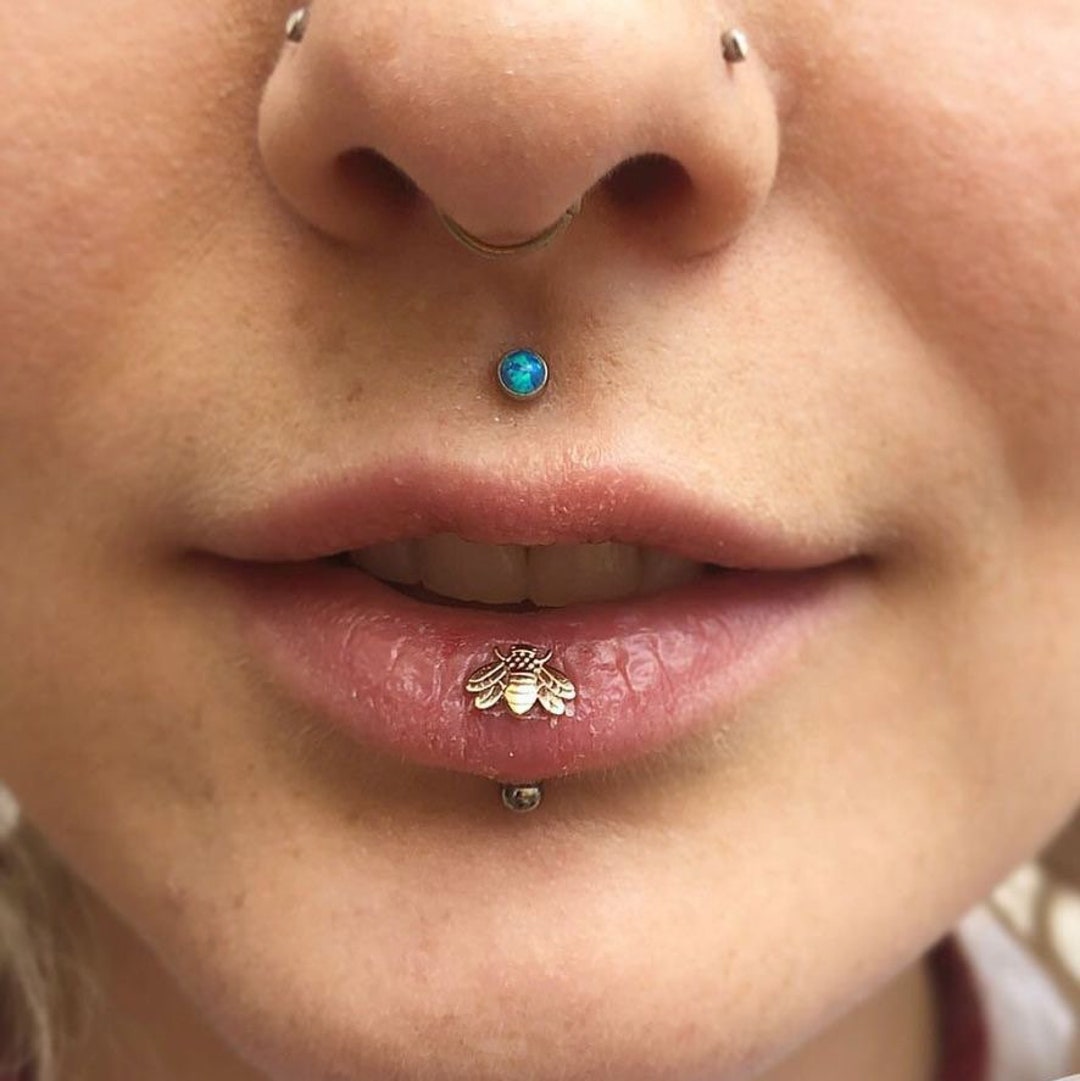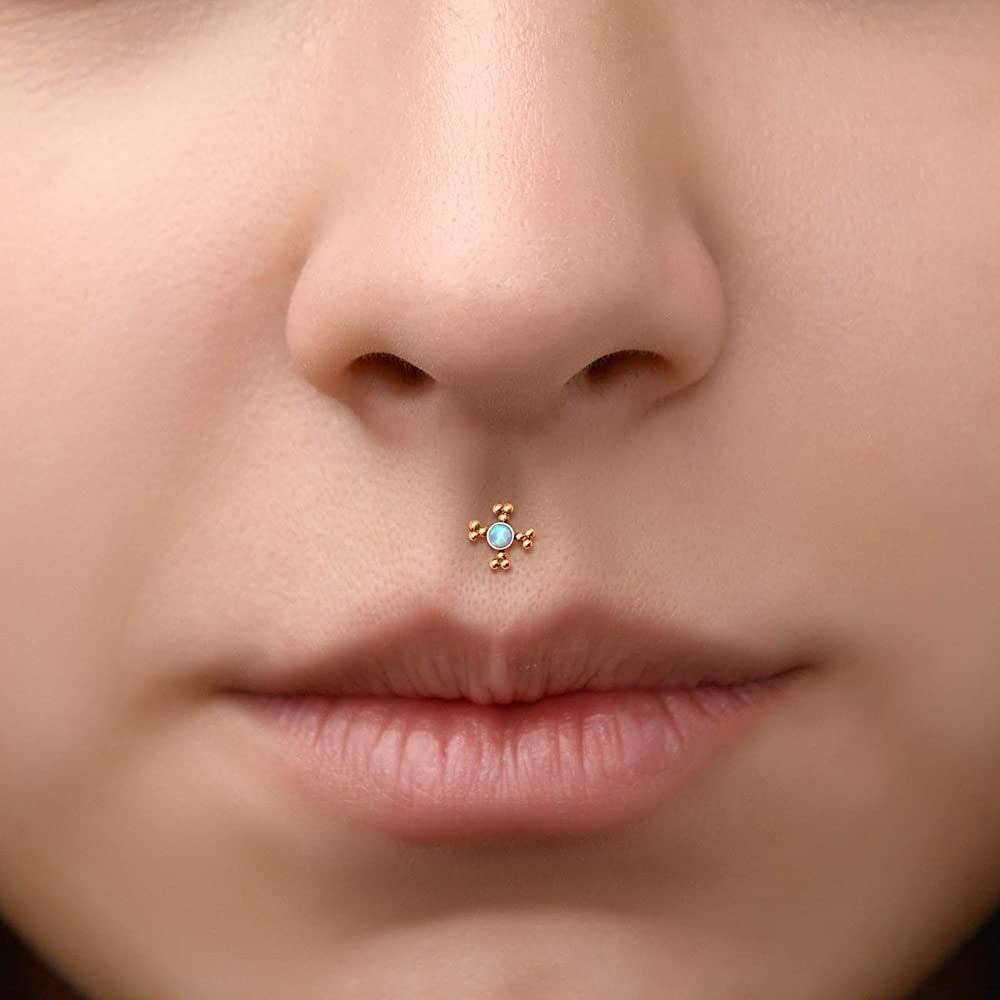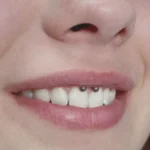A Medusa Piercing, or philtrum piercing, is a type of lip piercing that has been increasingly common in recent years. New research shows that medusa piercings are in the top five most sought lip piercings, and millions of individuals throughout the world have one.
Piercing the middle of the top lip, right above the cupid’s bow, is a popular way to draw attention to one’s grin. The medusa piercing is becoming increasingly popular as a fashionable and functional addition to any collection of body piercings. The purpose of this article is to educate the reader about the origins, procedure, and aftercare of medusa piercings, as well as offer helpful advice for a positive healing experience.
History of Medusa Piercing
There is little known about the history of the Medusa Piercing, often called a philtrum piercing. Lip piercing, however, has been practiced by many cultures for thousands of years, with the oldest documented piercings occurring in Mayan and Aztec societies. Commonly employed for ritual or ceremonial purposes, these piercings have also come to stand as emblems of sexuality, strength, and prestige.

Lip piercings are now considered a trendy way to express oneself and add visual interest to one’s appearance. Many people today choose to express their individuality and sense of style with a Medusa Piercing, which has surged in popularity in recent years.
The piercing consists of making a small hole in the center of the upper lip, right above the cupid’s bow, and is typically done to make one’s smile look more attractive. Although the history of the Medusa Piercing is shrouded in mystery, it remains a popular option for individuals seeking a distinctive and fashionable body piercing.
Placement and Anatomy of Medusa Piercing
A philtrum piercing, or Medusa piercing, is a piercing in the center of the upper lip, above the cupid’s bow. The dip between the bridge of the nose and the top of the lip is called the philtrum.
Medusa’s strategic location The labret, the part of the face that is below the lip and above the chin, is avoided at all costs when selecting a piercing site. Jewelry should be inserted into the piercing from the top of the philtrum and exit via the bottom of the lip.

Because of its proximity to major nerve endings and blood vessels, the philtrum deserves special attention from anyone considering a Medusa Piercing. Its proximity to the mouth makes it susceptible to oral germs and other diseases, which can cause swelling and healing issues.
It is crucial to select a piercer who is well-versed in the anatomy and location of Medusa Piercings in order to guarantee proper placement and prevent difficulties. In addition to making sure the piercing is done safely and correctly, the piercer can also advise you on the optimal location based on your unique anatomy.
Also See: Smiley Piercing: A Trending Body Modification
Types of Jewelry Suitable for Medusa Piercing
1. Labret Studs

The standard piece of jewelry for Medusa Piercings is a small, flat-backed disc on a post that travels through the lip tissue and emerges on the underside of the lip. Surgical steel, titanium, and bioplast are just a few of the materials that can be used to create a pair of labret studs, and they can be embellished with any number of stones and other ornaments.
2. Rings
A Medusa Ring is a type of lip piercing that resembles a labret stud but has a circular barbell instead of a flat disc that penetrates the lip and emerges from the underneath. Surgical steel, titanium, and bioplast are just some of the materials that can be used to create rings, and these bands can be further customized with a wide selection of stones and other embellishments.
3. Barbells

A straight bar penetrates the lip tissue and emerges from the bottom of the lip, much like labret studs, but with a disc instead of a flat back. Surgical steel, titanium, and bioplast are just a few of the materials used to create barbells, and they can be adorned with any number of stones and other ornaments.
4. Nostril Screw

A piece of jewelry known as a “nasal screw” consists of a curved bar with a screw-on end. Because of the potential for damage if the jewelry is unintentionally removed from a Medusa piercing, the usage of this sort of jewelry in a Medusa piercing is not as prevalent as it once was.
Pain Level During the Piercing Process
The Medusa Piercing, also known as a philtrum piercing, can cause varying degrees of discomfort in its recipients. Some people say they don’t feel anything at all during the piercing, while others say it hurts rather bad.
A Medusa piercing’s level of discomfort can be affected by a number of variables, such as:
- Anatomy: The degree of discomfort might vary depending on factors including the individual’s anatomy and where on the philtrum the piercing was performed. Some people’s philtrums are more sensitive than others, which might make the sensation of pain more intense for some people.
- Nerve endings: Piercing can be more excruciating because of the philtrum’s concentration of sensitive nerve endings.
- Anxiety: Those who are nervous or stressed out about getting their piercing may feel more pain than others.
- Pain tolerance: Some persons may experience less discomfort than others since their pain threshold is lower.
It’s crucial to remember that most piercings only take a few seconds, and the pain often goes away soon after. Pain can be managed throughout recovery with over-the-counter medications such as ibuprofen or acetaminophen.
Inquire with your piercer about the pain involved in a Medusa Piercing if you’re worried about it. Furthermore, they can offer advice on how to lessen the pain of getting pierced, such as breathing deeply and remaining calm.
Related: Cartilage Piercings: The Lowdown on Risks, Healing and Style
Cost of Medusa Piercing
Numerous variables affect how much a Medusa piercing will set you back, including as the piercer’s level of expertise, the quality of the jewelry they use, and the area of the body being pierced. A Medusa piercing might cost $40 to $150 or more on average.
In deciding on a piercer, keep in mind that the piercing price is only one consideration. To lessen the possibility of difficulties and guarantee a pleasant healing experience, choose a piercer who is both skilled and trustworthy and who employs sterile procedures and high-quality jewelry is essential.
It depends on the policy, however if the piercing is done by a medical professional, it may be covered. Contact your insurance company or piercer if you have questions regarding covering the cost of the piercing.
Healing Time
Medusa piercings can take anywhere from four to six months to heal, while this time frame is very variable from person to person. Taking good care of the piercing during this period will help prevent infection and speed up the healing process.
Here are some broad recommendations for handling the recovery process:
- Maintain the area’s tidiness.
- Stay away from the piercing, and don’t touch it.
- Stay away from pools and hot tubs.
- Avoid altering jewelry
- Avoid removing jewelry
Related: Ashley Piercing: Ultimate Guide to This Unique Body Modification
Choosing a Piercing Professional
Qualifications and Experience of a Piercing Professional
If you want your Medusa Piercing to go well and without any complications, it is imperative that you locate a piercing practitioner who is not only knowledgeable but also has previous experience in the field. When looking for a piercer, the following should be kept in mind for optimal results:
1. Training and certification
Find a piercer who has the appropriate training and qualification, such as a certification from the Association of Professional Piercers (APP) or a certification from another organisation that is analogous.
2. Experience
Selecting a piercer who has previous experience in doing Medusa Piercings will help boost the likelihood of a favourable outcome for the procedure.
3. Sterilization and hygiene practices
Look for a piercer who uses disposable needles and sterilizes all of the equipment before each use, since these are two examples of the stringent sterilization and hygiene protocols they adhere to.
4. Reputation
You can identify a piercer who has a solid reputation in the neighbourhood by reading reviews and asking for referrals from friends and family members.
5. Communication skills
Pick a piercer who can interact with you easily and provide you answers to all of your inquiries in a way that leaves you feeling satisfied, as this will make you feel more at ease and give you more self-assurance when getting pierced.
Ask These Questions to Your Piercer
It is crucial to educate yourself and ask the proper questions before getting a Medusa Piercing in order to guarantee that the outcome is as positive as it can possibly be. The following is a list of questions that you should consider asking your piercer:
- Do you have credentials and experience?
- How long have you been piercing with a Medusa needle?
- Do you have any samples of your work that I can see?
- When it comes to Medusa Piercings, what kind of jewelry do you suggest?
- To what extent does your aftercare plan extend?
- What sort of problems or illnesses did you encounter after getting a Medusa piercing?
- What sort of sanitization and cleanliness procedures do you have in place?
Tips for Changing Jewelry and Avoiding Irritation
- Clean hands: Change your jewelry only after you’ve washed your hands well and made sure they are bacteria-free. Before touching either the piercing or the jewelry, wash your hands thoroughly with soap and water.
- Clean the jewelry: Use an antiseptic solution like saline, witch hazel, or alcohol to disinfect the area before placing the new jewelry. In other words, this will aid in lowering the likelihood of infection.
- Soak the piercing: It’s best to soak the piercing in warm saline solution for a few minutes before removing the old jewelry. As a result, any scar tissue will soften, and you can change your jewelry without as much discomfort.
- Use lubricant: A drop or two of water-based lubricant applied to the jewelry’s end and the piercing’s inside will assist reduce friction and make swapping pieces easier.
- Change the jewelry slowly: Make sure you carefully and slowly switch out the jewelry. If you’re feeling any sort of pain or discomfort, it’s best to take a break and give yourself a few minutes to recover before continuing.
- Clean the piercing: When switching your jewelry, use an antibiotic to disinfect the piercing and then let it dry naturally. Do not put any cosmetics or other substances on the piercing or touch it with unwashed hands.
- Avoid tight clothing: Tight clothing can cause friction and irritation around a fresh piercing. Dress comfortably, but not baggy, and stay away from anything that might rub the piercing.
- Give it time: Altering the jewelry in a fresh piercing can lead to some discomfort and swelling. This is quite typical and should resolve itself in a few days. Get in touch with your piercing professional or a doctor if the redness, drainage, or pain persists beyond a few days.
Cleaning and Maintaining the Piercing
If you want your Medusa piercing to heal properly and stay infection-free, you must take good care of it. Care for your Medusa piercing with these suggestions:
- Clean the piercing twice a day with saline, witch hazel, or piercing-specific disinfectant. Soak a cotton ball in the solution and carefully clean around the jewels. Rinse the piercing well after cleansing.
- Avoid alcohol, hydrogen peroxide, and harsh soaps on the piercing since they irritate the skin and impede healing.
- Touching the piercing with unwashed hands might spread bacteria and cause infection.
- Swim in pools, hot tubs, and other bodies of water only when the piercing is fully healed to avoid introducing bacteria.
- Overcleaning the piercing can cause irritation and delay recovery. Avoid overcleaning the piercing.
- Change jewelry only after the piercing is totally healed to avoid introducing bacteria.
- If the piercing has redness, swelling, discharge, or pain, remove the jewelry and rinse it with saline. If symptoms continue, consult a piercer or doctor.
- Medusa piercings normally heal in 4–6 months. To heal the piercing properly, be patient and clean and maintain it.



